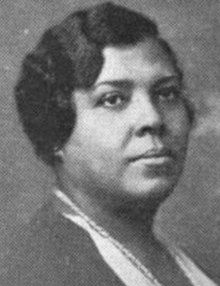Daisy Elizabeth Adams Lampkin
Daisy Elizabeth Adams Lampkin | |
|---|---|
 Daisy E. Lampkin, from a 1936 magazine | |
| Born | Daisy Elizabeth Adams August 9, 1883 Reading, Pennsylvania, U.S. |
| Died | March 10, 1965 (aged 81) |
| Occupation(s) | Activist, suffragist, clubwoman |
| Spouse |
William Lampkin (m. 1912) |
Daisy Elizabeth Adams Lampkin (August 9, 1883 – March 10, 1965) was an
Early life
Born on August 9, 1883, in Reading, Pennsylvania,[1] Daisy Elizabeth Adams was educated in Reading, Pennsylvania. She was the daughter of George Adams, born in Virginia, and of Rose Proctor born in 1860 in Charles County, Maryland. Daisy's maternal grandparents were Joseph Jenifer Proctor and Elizabeth Swann, free persons of color.
After completing her formal education in the public school system, she relocated to
It was also during this time that Lampkin became intimately involved with the national framework of the black women's club movement. Her leadership within the women's club movement introduced her to the leadership circles within the federation of women's clubs, particularly the
Civil Rights Movement
Upon securing the right to vote, Lampkin became increasingly involved in civic engagement and civil rights advocacy effort on both the local and national level. She served as Chairwoman of the Allegheny County Negro Women's Republican League, vice-Chairwoman of the Negro Voters League of
Field Secretary of the NAACP
These efforts would eventually lead to the national secretary of the NAACP, Walter White recruiting Lampkin as the first field secretary for the organization in 1930. Here Lampkin's efforts to organize and bolster the image of the NAACP nationally have become legendary. In 1931, Lampkin single-handedly organized the NAACP's 1931 National Convention in Pittsburgh. Her fundraising and organizing skills so impressed NAACP leadership that in 1935, she was moved from regional to National Field Secretary of the organization. That same year, while continuing to establish local NAACP chapters and participating in fundraising efforts, Lampkin along with White, spearheaded the organization’s drive to pass a federal anti-
Legacy
In addition to her lobbying, organizing and fundraising efforts, Lampkin has also been credited with recruiting a young Baltimore attorney and future Supreme Court Justice,
Death
While she resigned as national field secretary in 1947, Lampkin continued to serve on the organization's
See also
References
- ^ Nichols, C. (October 30, 2007). "Daisy Lampkin (1884–1965)". BlackPast. Retrieved May 30, 2019.
- ^ Giddings 1984.
- ^ Giddings 1984, p. 209.
- ^ "Daisy E. Lampkin - Pennsylvania Historical Markers on Waymarking.com". www.waymarking.com.
- ^ "Daisy Lampkin, 1883–1965". The Homewood Cemetery Historical Fund. 2015. Retrieved November 13, 2015.
Sources
- Axinn, J., &. Mark J. Stern (2008). Social Welfare: A history of the American response to need. Boston: Allyn and Bacon.
- Giddings, P. (1988). In Search of Sisterhood: Delta Sigma Theta and the challenge of the black sorority movement. New York: HarperCollins.
- Giddings, P. (1984). When and Where I Enter: The impact of black women on race and sex in America. New York: HarperCollins.
- "Daisy Lampkin. (2006, January 31)". Answer.com. Retrieved November 16, 2009.
- Hine, D. H. (2006). The African American Odyssey, 3rd edn. Upper Saddle River: Pearson Education, Inc.
- Houck, D. W. (2009). Women and the Civil Rights Rovement, 1954–1965. Oxford: University Press of Mississippi.
- Levin, Steve (1998, February 2). "Daisy Lampkin was a dynamo for change". Pittsburgh Post-Gazette.
- White, D. (1999). Too Heavy a Load: Black women in defense of themselves 1894–1994. New York: Norton.
